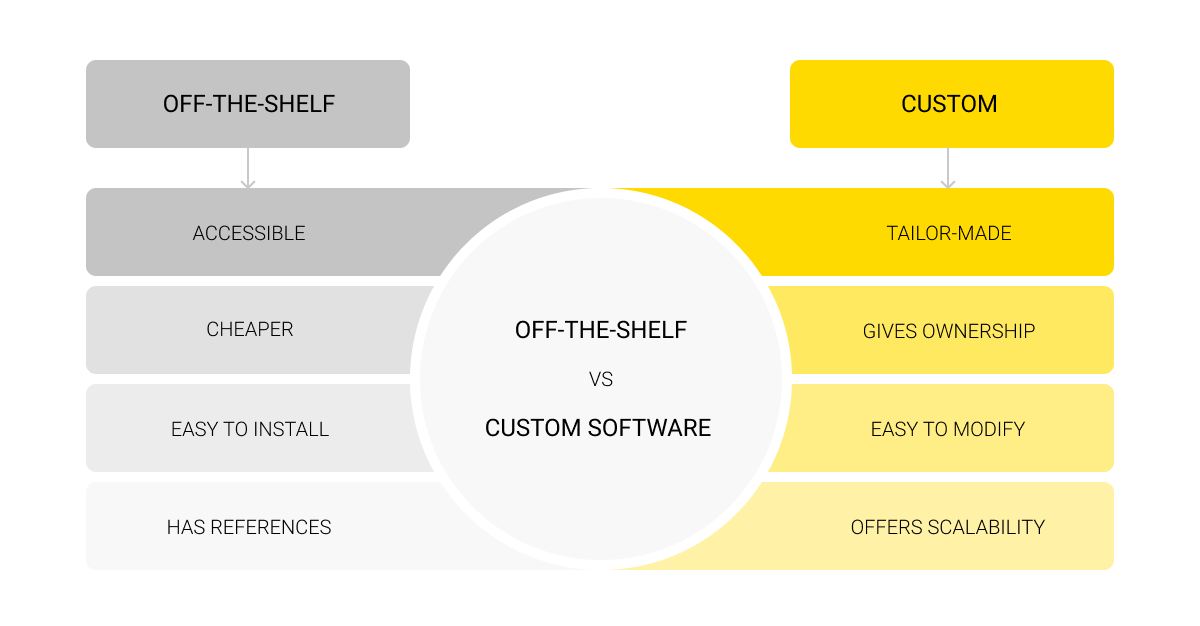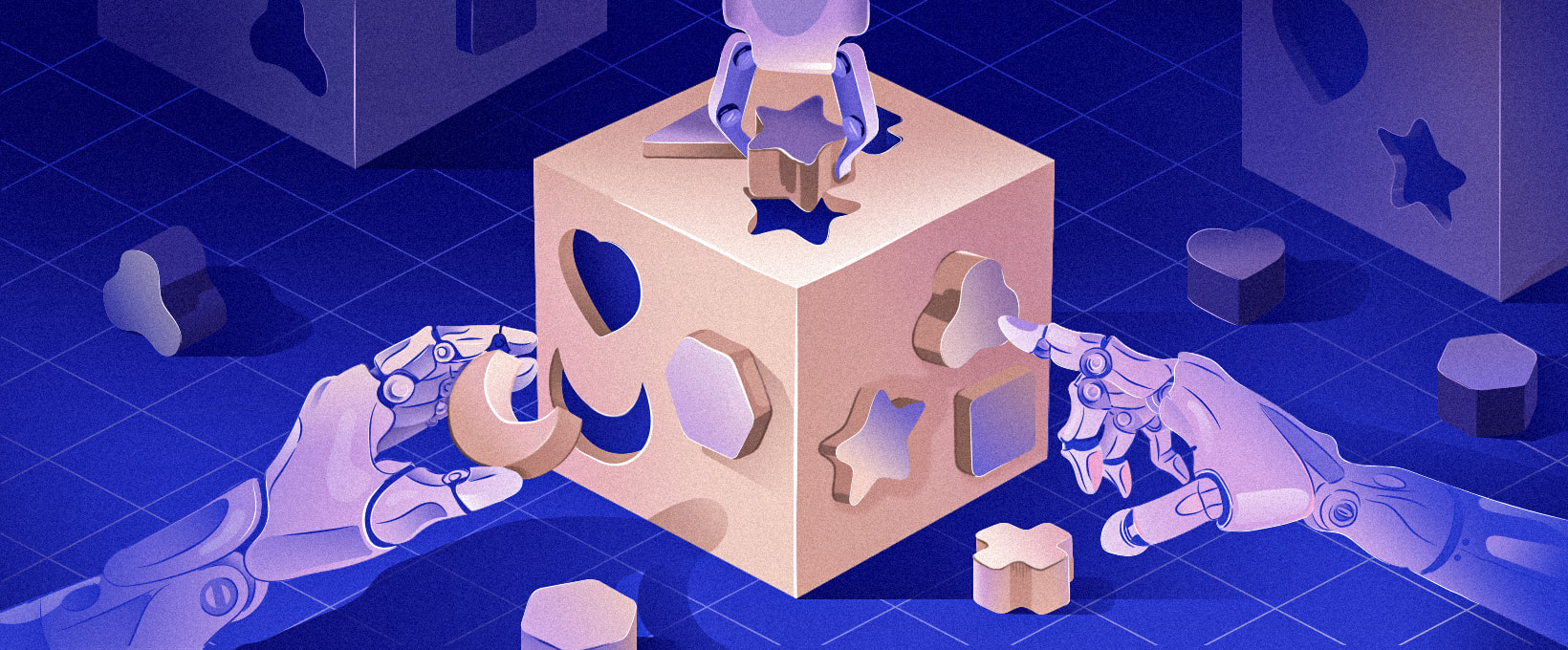- Key advantages and disadvantages of off-the-shelf software
- Significant pros to be aware of
- Relative cons of standard products
- What is bespoke software?
- The value and trade-offs of specialized products
- What are the core benefits of custom software over off-the-shelf solutions?
- Inevitable disadvantages of bespoke alternatives
- Custom software and off-the-shelf solutions: a summary
- Wrapping up
Companies across the globe are investing in all-encompassing digital transformation projects. This creates a huge demand for software tools that actually add value – whether custom-made or ready-to-use. This trend affects organizations of all types.
In 2019, before COVID, global IT spending reached $3.8 trillion (Statista). Since then, the pace of digitalization has accelerated, and in 2025, spending is expected to reach $5.61 trillion (Gartner).
For sure, these totals cover various heterogeneous “one vs. another” facets: hardware vs. software, coding per se vs. design vs. QA, training vs. incentives vs. daily management, and any other tech-related “vs” possible.
There is one more distinction to be aware of: custom software vs. off-the-shelf solutions. And here, we’ll outline the primary contrasts between them and point out the aspects where they overlap.
Key advantages and disadvantages of off-the-shelf software
So, what is behind this concept? Such software is pre-configured for widespread use. Typically, it allows little or no customization and is ready for instant utilization, right upon installation. Examples of this product category include Windows, Oracle, SAP, Salesforce CRM, and similar offerings. Any employee tasked with fulfilling their daily jobs, even when they have several bespoke suites at hand, must be well-familiar with some tools of this kind.
Off-the-shelf programs are deliberately envisioned and delivered for broad and “all-round” generalized scenarios. In this capacity, they find extensive adoption in customer service, eCommerce, eLearning, travel and hospitality, the gaming industry, and various other sectors. These technologies effectively address a range of common tasks such as document processing, ticket booking, online shopping, database management, accounting and bookkeeping, customer request handling, you name it.
Regarding pricing plans, the aforementioned products mostly operate on a subscription model. The fee amount is frequently determined by a combo of various factors, including the duration of usage, team size, and the concrete capabilities sought.
Now, let’s look at the advantages and disadvantages of off-the-shelf software.
Significant pros to be aware of
Such “pre-packaged” systems and applications have several advantages, encompassing cost-effectiveness, immediate usability, and a predictable set of features. These are their main strengths, as we see them:
- Affordability. Sharing expenses among users lowers the need for major initial spending. Nevertheless, it is pivotal to prudently assess the potential hidden long-term price tags associated with these applications, especially when planning for business expansion, be it about vertical or horizontal scaling;
- Quick setup and instant availability. Opting for pre-configured software works well when launching it as quickly as possible is a priority. However, you shouldn’t overlook the intricacy of your business processes;
- Proven quality. The fact that such applications remain relevant and evolve over time is evidence of their decent quality. Otherwise, users would have abandoned them. Still, conducting thorough research, including reading user reviews and resorting to free trial periods, is highly recommended before making a final decision. By following these steps, you can avoid buying a product without fully understanding its value and how well it fits your business needs.
Relative cons of standard products
Now let's give some thought to typical obstacles you might face when dealing with products of this kind. From our point of view, i.e. a globally dispersed tech team crafting bespoke tools, we would focus on these shortcomings:
- Limitations in customization are apparent. While most products of this kind permit certain adjustments, implementing them is often time-consuming and costly. Despite this, the outcome rarely matches the accuracy and flexibility of solutions built for a dedicated industry or use case;
- Excess functions that add little value. Pre-built applications tend to offer an extensive set of tools, many of which remain untouched in practice. This can complicate usability and inflate costs without delivering real benefits – similar to buying a luxurious sports car when a simple, practical vehicle would suffice. What’s more, these tools may lack certain capabilities that are vital for achieving your objectives;
- Integration issues can occur, creating difficulties if the software doesn’t align with your existing IT environment. This misalignment may prevent you from fully leveraging modern technologies or realizing the benefits that these pre-built solutions are intended to provide;
- The cumulative effect of the above-listed issues is an elevated ultimate cost for such software. Not only does it entail ongoing investments, but its lack of uniqueness and competitive edge may also result in financial losses.
Ready-made digital products are indeed a practical and economical option, especially for firms seeking rapid deployment and standardized functionality.
That said, the downsides – like lack of flexibility, unnecessary or missing features, integration hurdles, and hidden expenses – make it crucial to evaluate them carefully. It’s important for businesses to consider both the quick wins and the future trade-offs when deciding whether such software supports their strategy and day-to-day processes.
Let’s now turn our attention to the other side of the equation.
What is bespoke software?
In essence, it's any unique digital product without counterparts in the market. Renowned global brands like Amazon, TikTok, and Uber employ such software in their activities, but its custom benefits extend beyond corporate giants. SMEs can thrive with it as well. Such solutions showcase genuine creativity and can play a key role in advancing your projects and day-to-day operations to the next level.
There is significant demand for such products among enterprises, especially those seeking business process automation, offering eCommerce services, and undertaking Big Data projects (GoodFirms). The heightened security level of such systems makes them indispensable for developing effective data-driven applications in fintech, healthcare, and logistics management.

The expense of undertaking these custom projects depends on many elements – your particular sector, the schedule for delivery, the scale and complexity of your undertaking, and the specific functionality required. Bespoke projects are always bespoke, after all. This variability serves as one more thing all teams should contemplate while dealing with the bespoke software vs off-the-shelf dilemma.
Just consider this fact: the global niche of custom development was estimated at roughly $30 billion back in 2022. Forecasts suggest that by 2032, it could approach $200 billion. Clearly, many economic agents vote for bespoke “bets,” any potential “vs” notwithstanding.
Most of those customers that prefer bespoke suites, predictably, belong to the segment of large enterprises (58%), followed by IT and Telco (23%).
The value and trade-offs of specialized products
Many organizations continue to work with our custom software development company as their preferred technology partner. The main reason is Andersen’s ability to provide reliable, fully tailored solutions that address all the needs our clients consider essential.
Our team has an in-depth grasp of what makes these digital products unique. Here, we’ll explore both the advantages and the potential limitations that come with them.
What are the core benefits of custom software over off-the-shelf solutions?
The range of advantages of custom software over off-the-shelf solutions is impressive, including:
- Thorough customization. Normally, custom processes begin with comprehensive research on your business, conducted by top-notch Business Analysts and System Analysts. This ensures a detailed requirement specification that outlines the bespoke project scope, timing, and outcomes;
- Adaptability. These kinds of products embed naturally within your organization, aligning with development plans and fostering long-term growth rather than hindering it;
- Competitive edge. Uniqueness is among the most significant custom software development benefits. It empowers your most creative and high-impact initiatives. As a result, such exclusivity helps differentiate your company from competitors;
- Enhanced security. Custom-built software is crafted specifically for your organization, which means there’s no identical version for hackers to target. Additionally, trusted technology providers follow internationally recognized security standards, ensuring your system is well-guarded against breaches and data leaks, and giving you confidence in the safety of your digital assets;
- Seamless integration. Tailor-made applications connect well with existing tools, enabling easy data sharing across teams and supporting consistent, trouble-free operations;
- Optimized performance. Solutions of this kind help employees carry out their tasks faster. Thanks to them everything is running smoothly, and a company sees a significant improvement in its operations;
- Scalability. As your business grows, expands, and enters new markets, your digital solutions can evolve alongside it. New features and capabilities can be added, allowing you to manage increased user traffic, transactions, or data volumes without major overhauls. This supports long-term growth and helps reduce repeated migration costs;
- Regulatory compliance. Industry-specific requirements can be incorporated from day one, helping businesses meet legal and regulatory standards in sectors such as healthcare, fintech, and logistics.
Inevitable disadvantages of bespoke alternatives
When it comes to bespoke and off-the-shelf software, keep in mind: any conceivable advantage is achieved via inevitable compromises. There is always a “versus” factor to consider. With custom solutions, everything you receive is designed, built, adapted, tested, and refined to fit your company’s needs down to the smallest detail.
However, when considering engaging a professional engineering team, it’s essential to carefully weigh the risks and keep the following potential drawbacks of custom projects in mind:
- Extended time frames. Building things from the ground up necessitates meticulous planning and the involvement of exceptional professionals, significant sums, and so on. Consequently, the engineering timeline, encompassing the discovery phase and the testing stage, may extend from several months to well over a year. For many, that is the most significant “vs” in comparison with standard products;
- Significant upfront costs. Products built for specific purposes require advanced expertise and tend to be costly. All expenditures, however, are defined in the specification document, preventing unexpected spendings. Although the starting investment is substantial, the goal is to generate long-term value;
- Continuous post-launch assistance. A custom package demands dedicated support services. Yet, with a provider experienced in your solution, maintenance runs smoothly, and any issues can be resolved promptly;
- Dependency on the development team. Since such an application has no direct analogs, organizations often rely heavily on the engineering team that developed it. Losing access to key developers or the provider can complicate updates, troubleshooting, or future enhancements;
- Limited external resources. Unlike widely used standard tools, bespoke solutions may have fewer tutorials, forums, or third-party plugins available;
- Potential for scope creep. Custom projects may experience shifting requirements or new feature requests during development. Without careful project management, this can lead to delays, increased costs, or deviation from the original objectives;
- Integration challenges. Even though custom software can be tailored to your current systems, unforeseen compatibility problems may occur with third-party tools, older systems, or standard industry solutions.
Digital products you order can be highly specialized and adaptable, yet there are still considerations that organizations must manage. Understanding these challenges early helps companies decide on the right course of action and optimize their resources.
Custom software and off-the-shelf solutions: a summary
Understanding the difference between off-the-shelf software makes things easier. However, there’s no universal answer when choosing a particular digital product.
While pre-built systems and applications are faster to implement and often cheaper, bespoke solutions offer flexibility and room to grow. They can be designed to match your exact operations, processes, and requirements. Considering current needs alongside anticipated developments helps make sure your technology investments continue to support overall business strategy.

Wrapping up
Nowadays, the vitality of your business hinges on robust code, be it for streamlining financial operations, tracking production workflows, managing a clinic, or overseeing warehouse operations. Recognizing the profound impact of selecting the correct approach, Andersen's team consistently urges its customers to invest time in meticulously evaluating all possible answers concerning the “custom software vs. off-the-shelf alternatives” dilemma.
If our team takes on your innovative projects, our experts bring a wealth of experience from successful, challenging initiatives. They recognize the importance of project development process and are equipped to tackle challenges effectively. They concentrate on boosting the effectiveness of custom software while reducing possible downsides, aiming to eliminate obstacles wherever they arise.
Whenever you feel like you require bespoke assistance, feel free to reach out to us for more details. Our team is always ready to support you in all your digital initiatives. By giving responsibility for your plans to us, you also contribute to IT outsourcing to Ukraine, as many of our staff members are located in this country which needs help now.





